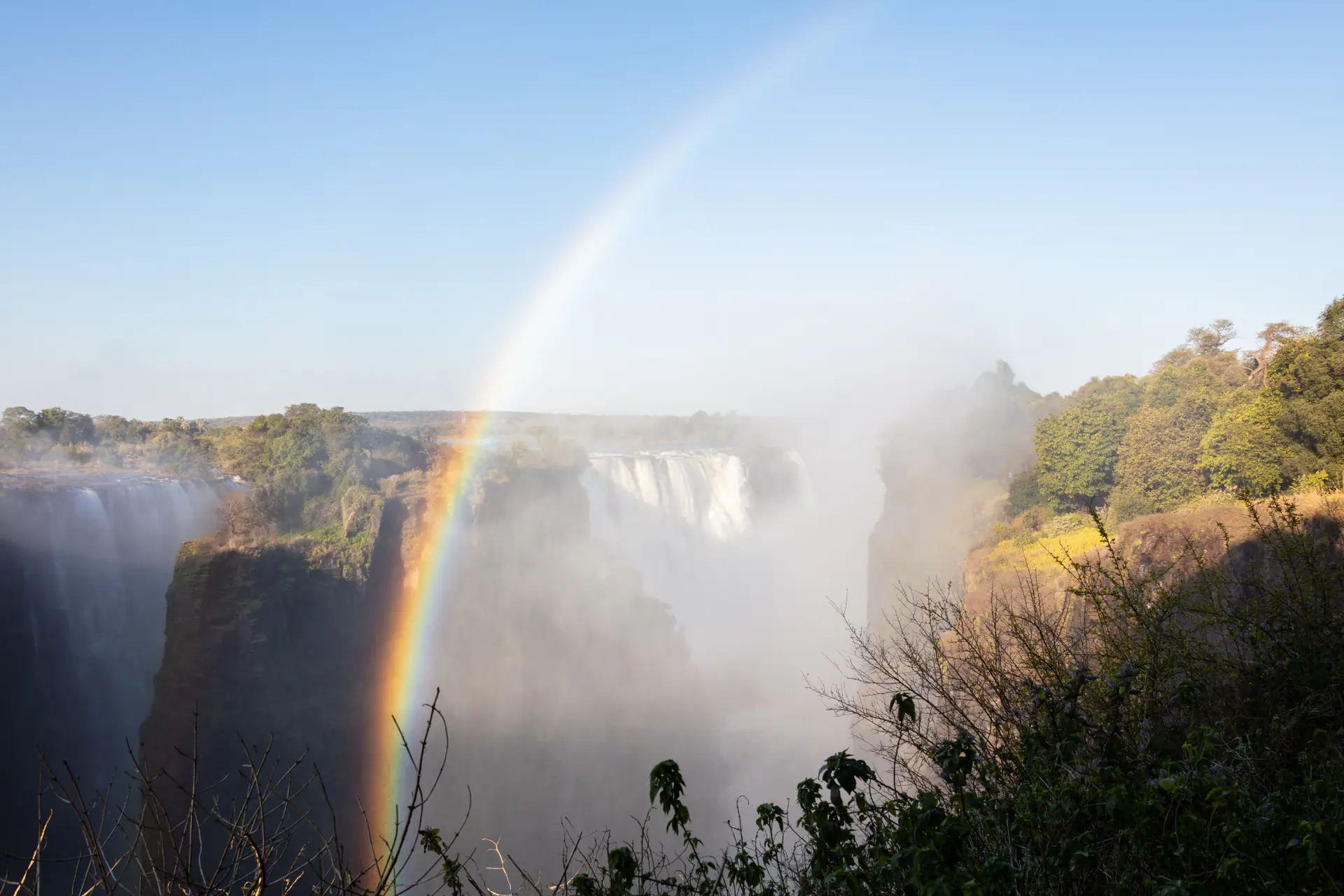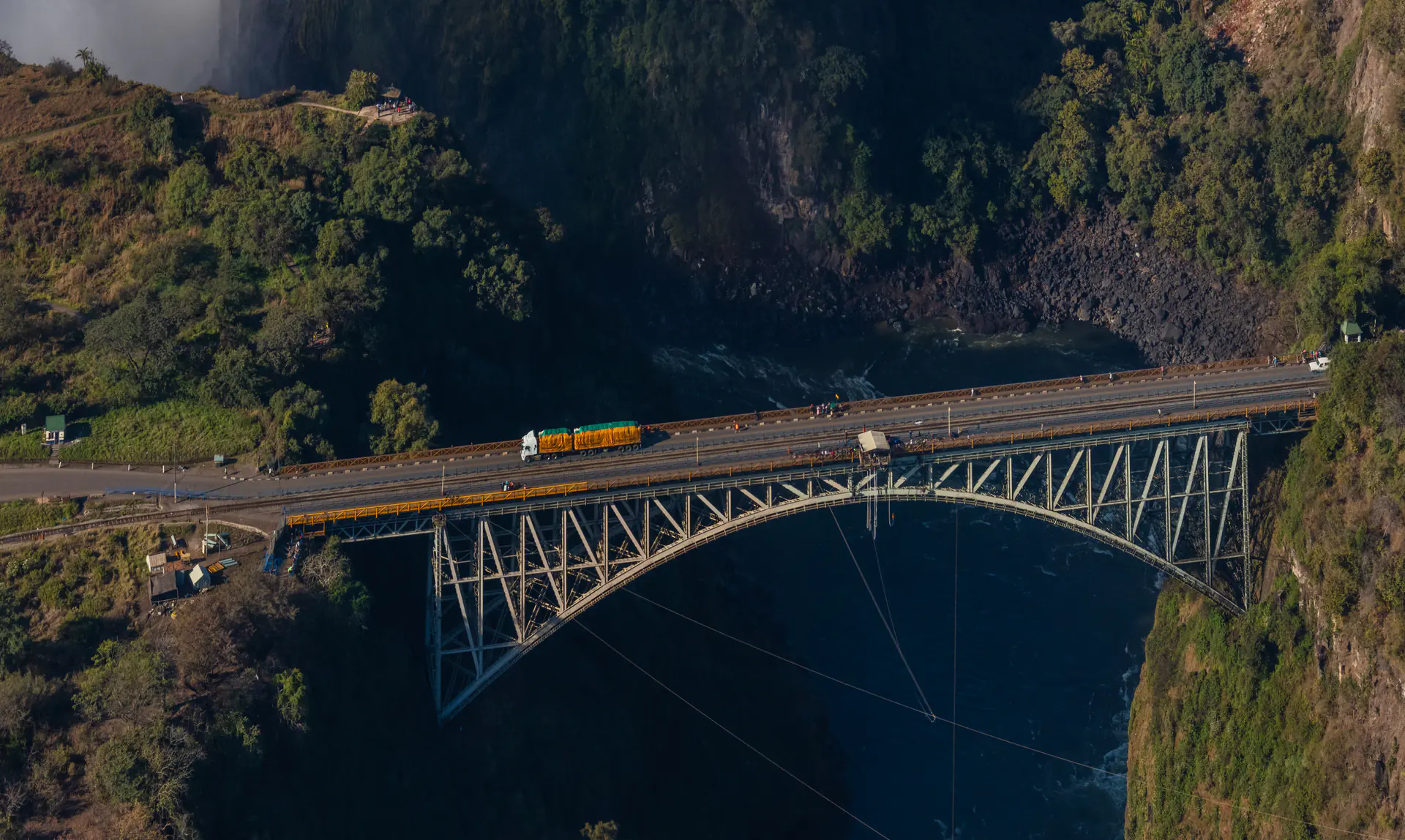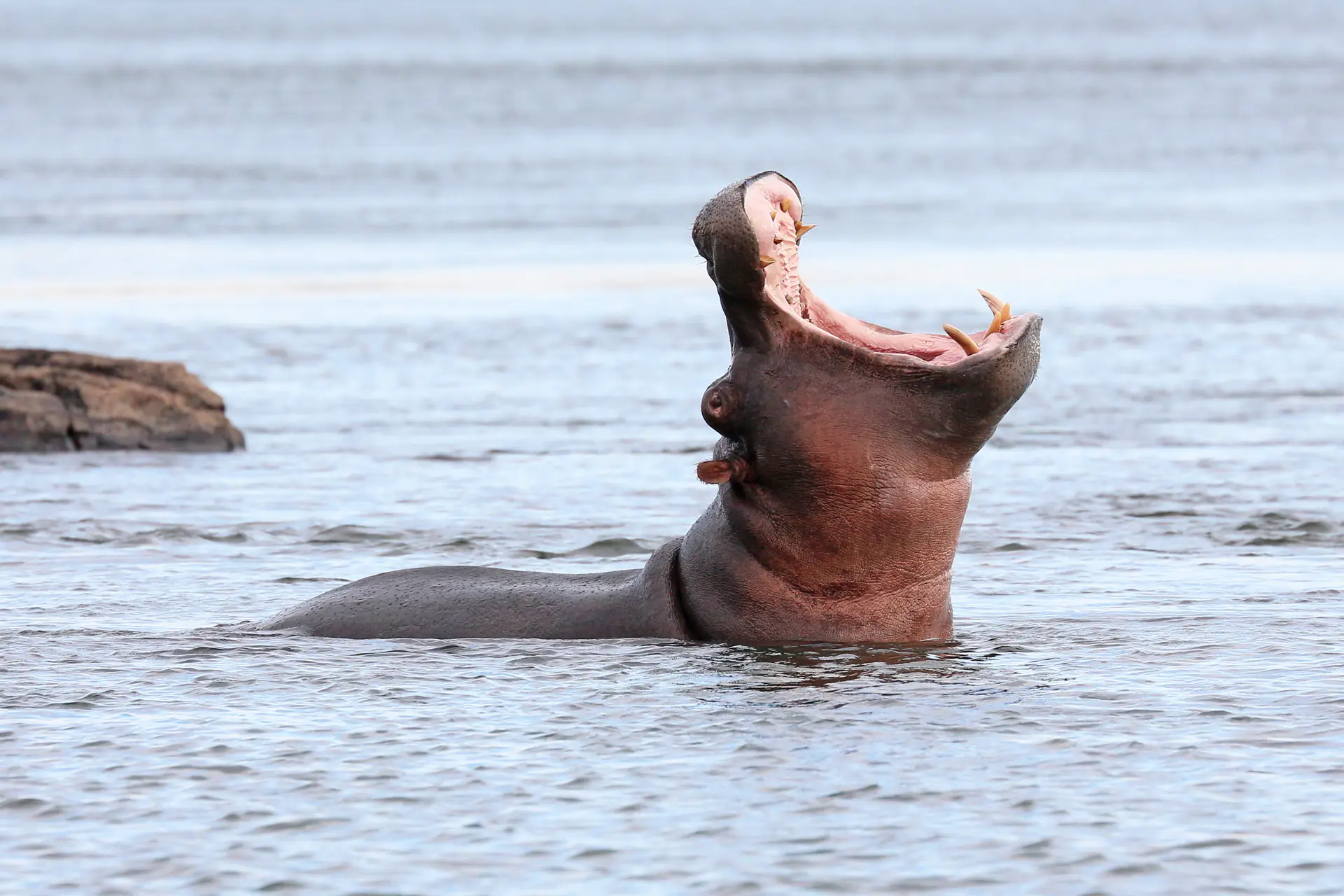
Victoria Falls: Devil's Pool, Batoka Gorge & Zambezi Wildlife
Zambezi River's 1,708-Meter Curtain of Falling Water
About This Site
The Zambezi River carved Victoria Falls through basalt rock over 2 million years as water exploited geological weaknesses, creating the world's largest curtain of falling water spanning 1,708 meters wide and plunging 108 meters into dramatic gorges below. This ongoing erosion process continues moving the waterfall upstream at approximately one meter per millennium, forming eight successive downstream gorges marking previous cataract positions. Scottish explorer David Livingstone documented the falls in 1855, introducing the European name for what indigenous Tonga and Lozi peoples had called Mosi-oa-Tunya ("The Smoke That Thunders") for centuries, establishing it as a premier UNESCO World Heritage Site straddling the Zimbabwe-Zambia border with exceptional wildlife including elephants and hippos along riverbanks.
Why It Matters
Represents the world's largest curtain of falling water, demonstrating exceptional geological processes through ongoing gorge erosion and basalt plateau evolution spanning two million years.
Planning Your Trip
Essential information for visiting this destination
Getting There
International flights arrive at Harry Mwanga Nkumbula International Airport in Livingstone, Zambia (10 kilometers from town), or Victoria Falls Airport in Zimbabwe (22 kilometers from town), both offering connections via Johannesburg, Cape Town, and regional hubs. Multiple airlines including South African Airways, British Airways, and regional carriers operate scheduled services year-round. Cross-border shuttle buses connect both towns enabling visitors to explore both Zimbabwe and Zambia sides, running hourly during daylight hours. Local taxis and hotel transfers provide door-to-door service, while walking between Victoria Falls town and the falls entrance takes approximately 15-20 minutes along safe paved roads with pedestrian facilities.
Where to Stay
Victoria Falls town in Zimbabwe offers the widest accommodation selection from backpacker lodges to luxury safari camps, with convenient walking access to falls viewpoints and restaurants. The compact town center enables independent exploration while maintaining authentic African atmosphere with curio markets and vibrant local culture throughout the area. Livingstone in Zambia provides more budget-friendly options including excellent hostels and mid-range guesthouses, delivering relaxed colonial-era charm with riverside restaurants and local markets. The town sits further from falls viewpoints requiring transport, though Devil's Pool and Zambian-side activities base here. Luxury lodges line the Zambezi River upstream from falls on both sides, offering private game viewing, exceptional service, and exclusive atmosphere combining waterfall visits with wildlife encounters.
Where to Eat
Zambian cuisine features nshima maize porridge served with relishes including grilled tilapia from the Zambezi, kapenta small dried fish, and ifisashi vegetable stews with peanut sauce reflecting regional staples. Victoria Falls town restaurants specialize in international fare catering to tourists, while Livingstone establishments offer more authentic Zambian dishes alongside continental options. Both towns feature excellent boma dinner experiences with traditional music, dance performances, and grilled game meats including crocodile, kudu, and impala under starlit African skies. Sunset river cruises typically include drinks and canapés while wildlife viewing unfolds along scenic riverbanks. Local breweries craft Zambezi Lager and other regional beers, while South African wines dominate restaurant lists given regional trade connections.
Things to Do
Zimbabwe entrance costs $50 USD for foreign visitors offering superior waterfall views through extensive 1.7-kilometer pathways with 16 viewpoints. Zambia entrance costs $20 USD providing access to Devil's Pool ($125 USD total with Livingstone Island tour, September-December only, includes boat and guide). KAZA Univisa costs $50 USD enabling multiple visits to both sides over 30 days. Helicopter flights cost $165-350 USD for 13-30 minute flights delivering spectacular aerial perspectives revealing the falls' immense scale and rainbow formations. Microlight flights cost $165-185 USD for 15-minute experiences. Hot air balloon safaris cost $425-550 USD including champagne breakfast. White-water rafting expeditions cost $145-165 USD for full-day Grade V rapids through Batoka Gorge (August-December low water season), including equipment, guides, lunch, and transport. Half-day rafting costs $125-145 USD. Bungee jumping from Victoria Falls Bridge costs $160 USD for 111-meter plunge. Bridge swing costs $125 USD, gorge swing $95 USD, zip-line $75 USD. Combined adventure packages cost $200-350 USD for multiple activities. Sunset river cruises cost $50-75 USD for 2-hour wildlife viewing upstream with elephants, hippos, and crocodiles, including drinks and snacks. Full-day Chobe National Park (Botswana) safaris cost $160-220 USD including border crossing, game drives, and lunch. Walking safaris in Mosi-oa-Tunya National Park cost $85-125 USD for rhino tracking with armed guides. Full moon tours for moonbow viewing cost $50 USD (Zimbabwe after-hours entry).
Travel Essentials
Comprehensive travel insurance covering medical evacuation essential given limited advanced healthcare facilities, while regional eSIM plans providing both Zambian and Zimbabwean connectivity enable navigation and communication across borders though coverage remains variable in remote areas. Download offline maps before arrival for reliable navigation. KAZA Univisa simplifies border crossings for multiple visits to both countries over 30-day periods. Both countries use different electrical outlets (Type D/G), requiring universal adapters for electronic devices. Waterproof camera bags essential for protecting equipment in perpetual spray zones near viewpoints, while polarizing filters reduce glare for optimal photography. Pack quick-dry clothing in neutral colors, sturdy water-resistant shoes with excellent tread, high-SPF reef-safe sunscreen, and insect repellent for mosquito protection during November-April rainy season. Arrive at Zimbabwe side by 06:30 opening time securing quiet hours before tour groups arrive mid-morning, while afternoon light creates optimal rainbow conditions.
Loading map...
Visitor Information
Everything you need to know for your visit
What to Bring
Waterproof camera bag essential for spray zones, quick-dry clothing in neutral colors, sturdy water-resistant shoes with good tread, high-SPF reef-safe sunscreen, insect repellent (November-April), polarising filter for photography, 2-3 liters water.
Accessibility
Zimbabwe side offers paved pathways with moderate slopes accessing multiple viewpoints. Wheelchair access available to some viewpoints though spray zones and uneven paths limit full access.
Safety Tips
Paths become extremely slippery from constant spray. Devil's Pool requires swimming ability and operates only during low water season.
Natural Wonders

Main Falls Viewpoint (Zimbabwe)
The Zimbabwe side offers the most comprehensive waterfall perspectives through an extensive network of paved pathways stretching 1.7 kilometers along the gorge rim, accessing sixteen distinct viewpoints showcasing different sections of the falls system. The Rainforest Walk passes through vegetation sustained by perpetual spray mist, where rare plant species thrive in unique microhabitats created by constant moisture. Each viewpoint reveals different character from the powerful Main Falls to the dramatic Devil's Cataract, while the spray creates natural air conditioning cooling temperatures significantly. Peak flow February-May delivers overwhelming sensory experiences, though visitors should expect complete soaking from spray reaching viewing platforms. Pro tip: Visit Zimbabwe side at 2-4pm when afternoon sun position creates the most spectacular rainbows across Main Falls and Devil's Cataract--bring waterproof phone case and raincoat as spray completely drenches you at peak flow (February-May), but the rainbow displays are worth it.

Rainbow Over the Falls
Victoria Falls generates spectacular rainbow displays through perpetual spray illuminated by sunlight, creating brilliant color arcs spanning the gorge throughout daylight hours when conditions allow. During full moon periods, rare lunar rainbows or "moonbows" appear as ghostly white arcs across the spray, visible only at Victoria Falls and a handful of other exceptional waterfall locations worldwide. These ethereal nocturnal displays require clear skies and full moon timing, attracting photographers seeking unique natural phenomena. The constant spray ensures rainbow visibility remains high during peak flow months, while lower water seasons produce more concentrated displays. Position yourself strategically during morning or afternoon hours when sun angles optimize rainbow formation across the main cataract sections. Pro tip: Book lunar rainbow viewing during full moon nights ($50 USD Zimbabwe park entry after hours)--arrive around 7-9pm when the moon rises high enough to create ethereal white rainbows across the spray, a phenomenon visible at only a few waterfalls worldwide.

Batoka Gorge & Victoria Falls Bridge
Below Victoria Falls, the Zambezi River has carved eight successive gorges through basalt rock over two million years, creating dramatic canyons up to 120 meters deep marking previous waterfall positions as the cataract retreated upstream. The historic Victoria Falls Bridge completed in 1905 spans Batoka Gorge 128 meters above the river, representing extraordinary colonial-era engineering where Cecil Rhodes envisioned a Cape-to-Cairo railway. Today this 198-meter steel arch structure hosts bungee jumping operations and pedestrian walkways delivering spectacular waterfall views. The gorge system below supports world-class white-water rafting through Grade V rapids during low water season, while hiking trails descend into canyons revealing geological layers and erosion patterns demonstrating ongoing landscape evolution. Pro tip: Walk across Victoria Falls Bridge ($10 USD pedestrian fee) around sunset (5-6pm) for spectacular photos of the gorge and falls with golden light--the bridge provides unique perspectives impossible from either rim, and you can watch bungee jumpers plunge 111 meters if scheduled.

Devil's Pool Experience
Located on the Zambian side atop Livingstone Island, Devil's Pool offers one of the world's most thrilling natural swimming experiences where visitors can approach the falls' precipice edge during low water season September through December. Natural rock barriers create a safe pool when water levels drop below critical thresholds, allowing swimmers to peer over the 108-meter drop while feeling the Zambezi's powerful current. Access requires crossing the river by boat, swimming through channels, and scaling rocks with guide assistance, demanding reasonable fitness and swimming competence. This bucket-list experience delivers unmatched adrenaline while showcasing the falls' raw power from a unique perspective impossible during high water months when the pool becomes dangerously submerged. Pro tip: Book Devil's Pool for September-October when water levels are safest ($125 USD including Zambian park entry and boat)--avoid December when rising water makes the experience more dangerous, and understand this requires moderate fitness for swimming, rock scrambling, and handling strong currents.

Zambezi Wildlife Encounters
The Zambezi River ecosystem supports exceptional wildlife diversity with elephants frequently crossing between islands upstream from the falls, while large hippo pods congregate in calm waters providing dramatic wildlife viewing during sunset river cruises. Crocodiles bask on sandy banks, African fish eagles patrol for prey, and buffaloes graze along riverine vegetation. Mosi-oa-Tunya National Park on the Zambian side protects white rhino populations within accessible grasslands enabling guided walking safaris. Birdlife exceeds 400 species including spectacular kingfishers, herons, and seasonal migrants. Morning and evening game drives reveal giraffe, zebra, and antelope species, while the river's permanent water source attracts wildlife year-round, particularly during dry season months when surrounding areas experience water scarcity.
Historical Context
Geological Formation (2 million years ago)
Ongoing erosion processes carved Victoria Falls through basalt rock as the Zambezi River exploited geological weaknesses, creating eight successive gorges downstream marking previous waterfall positions. The falls continue retreating upstream at approximately one meter per millennium, demonstrating active landscape evolution through water erosion of volcanic plateau formations.
Indigenous Heritage (Pre-1855)
Indigenous peoples including the Tonga and Lozi communities revered the falls as Mosi-oa-Tunya ("The Smoke That Thunders") for centuries, with archaeological evidence suggesting human presence exceeding 100,000 years. Local traditions describe spiritual significance and seasonal ceremonies conducted near these sacred waters central to regional cultures and belief systems.
European Discovery (1855)
Scottish explorer David Livingstone became the first European to document the falls on 16 November 1855, naming them after Queen Victoria. His detailed descriptions sparked international interest, though he noted the falls' grandeur defied adequate written description through available means.
Tourism Development (1905-1980s)
Victoria Falls Bridge completion in 1905 enabled railway access, transforming the falls into a premier tourist destination attracting international visitors. Hotels, viewing platforms, and infrastructure development accelerated through the colonial era, though political instability during Zimbabwe's independence struggle temporarily disrupted tourism growth affecting regional economic development and conservation funding.
UNESCO Inscription (1989-Present)
UNESCO World Heritage designation in 1989 recognized outstanding universal value combining natural beauty with geological significance. Joint Zimbabwe-Zambia management frameworks established international cooperation protocols, while modern infrastructure balances conservation requirements with sustainable tourism development, protected area expansion, and wildlife corridor maintenance connecting regional reserves for ecosystem integrity.
Conservation
Current Status
UNESCO World Heritage Site since 1989 with joint Zimbabwe-Zambia management protecting waterfall systems and surrounding ecosystems through coordinated conservation frameworks and international cooperation agreements.
Challenges
- Climate change affecting Zambezi River flow patterns with drought years reducing water volumes significantly
- Tourism infrastructure development pressures requiring careful balance between access and conservation
- Water abstraction upstream for hydroelectric projects and agriculture affecting downstream flow rates
- Wildlife poaching in surrounding protected areas threatening elephant and rhino populations
- Cross-border coordination challenges requiring ongoing diplomatic cooperation for unified management strategies
Conservation Efforts
- Joint management committees coordinating Zimbabwe and Zambia conservation strategies, tourism development, and scientific research programs across international boundaries for unified ecosystem protection
- Rhino conservation programs in Mosi-oa-Tunya National Park increasing populations through anti-poaching patrols, community engagement initiatives, and breeding management strategies
- Rainforest restoration projects along gorge rim protecting endemic plant species sustained by perpetual spray mist and unique microhabitats created by waterfall moisture
- UNESCO monitoring missions assessing conservation effectiveness, climate change impacts, and tourism sustainability while providing technical guidance for adaptive management strategies
- Sustainable tourism certification programs ensuring visitor operations contribute to conservation funding while maintaining environmental standards and limiting ecological impacts on fragile waterfall ecosystems
Frequently Asked Questions
Absolutely--Victoria Falls showcases the world's largest curtain of falling water spanning 1,708 meters wide and plunging 108 meters, creating spray columns rising 400 meters high visible from 50 kilometers away. Spectacular rainbows, rare moonbows, and exceptional wildlife including elephants and hippos make it one of Earth's most dramatic natural wonders.
Zimbabwe side costs $30 USD entry, Zambia side $20 USD. Popular activities include Devil's Pool ($125-145 USD), helicopter flights ($150-350 USD), and white-water rafting ($130-165 USD). Budget $50-80 USD per day for basics, or $180-280 USD daily mid-range with accommodation and activities.
Zimbabwe side offers superior waterfall views with extensive walkways providing multiple perspectives of the falls' entire length, while Zambia side delivers closer encounters including Devil's Pool access and excellent views of the main cataract. Both sides merit visiting for comprehensive experiences requiring border crossings.
February-May offers peak flow with dramatic spray creating overwhelming displays, though mist can obscure views. August-January provides lower water revealing rock formations, better visibility, and Devil's Pool access. Both seasons deliver exceptional experiences with different character.
KAZA Univisa permits multiple entries to both Zambia and Zimbabwe for 30 days, costing $50 USD. Alternatively, purchase separate single-entry visas at border posts. Some nationalities receive visa waivers. Verify current requirements based on your passport well before traveling to avoid complications.
Plan a full day minimum to explore both Zimbabwe and Zambia sides. Spend 2 days for comprehensive waterfall viewing plus activities like Devil's Pool, helicopter flights, or white-water rafting. Allow extra time for wildlife viewing via sunset river cruises upstream.
Victoria Falls town (Zimbabwe) offers widest accommodation selection with walking access to falls viewpoints. Livingstone (Zambia) provides budget-friendly options with colonial charm but requires transport to viewpoints. Luxury lodges line the Zambezi River upstream on both sides combining waterfall visits with wildlife encounters.
Devil's Pool ($125-145 USD) operates September-December on Zambia's side during low water season. Book 4-8 weeks ahead through Livingstone tour operators as availability fills quickly. Includes island tour, breakfast, guide supervision, and precipice swimming. Swimming ability essential.
Pack waterproof camera bag for spray zones, quick-dry clothing in neutral colors, water-resistant shoes with good tread, high-SPF sunscreen, insect repellent (November-April), polarizing filter for photography, and 2-3 liters water. Arrive at Zimbabwe side by 6:30am opening for quiet hours before tour groups.
Cross-border shuttle buses run hourly between Victoria Falls town (Zimbabwe) and Livingstone (Zambia) during daylight hours. Local taxis provide door-to-door service. KAZA Univisa ($50 USD) simplifies multiple border crossings over 30 days. Walking between sides requires visa and immigration processing.
Victoria Falls is the world's largest curtain of falling water, where the Zambezi River plunges 108 meters along a 1,708-meter-wide basalt cliff. Famous for spray columns rising 400 meters high and spectacular rainbows, earning its local name "The Smoke That Thunders".
The Zambezi River carved Victoria Falls through basalt rock over 2 million years as water exploited geological weaknesses. Ongoing erosion continues moving the waterfall upstream at approximately one meter per millennium, forming eight successive downstream gorges marking previous cataract positions.
Moonbows are rare lunar rainbows appearing as ghostly white arcs across Victoria Falls spray during full moon periods. Visible only at Victoria Falls and a handful of exceptional waterfall locations worldwide, these ethereal nocturnal displays require clear skies and full moon timing.
Batoka Gorge offers world-class Grade V white-water rafting ($130-165 USD full-day) during low water season August-December. These thrilling rapids rank among the world's best, suitable for adventurous travelers with reasonable fitness. Book ahead during peak season for guaranteed spots on this bucket-list experience.
Zambezi River supports diverse wildlife including elephants, hippos, crocodiles, and buffaloes along riverbanks. Birdlife exceeds 400 species including African fish eagles and kingfishers. Nearby Mosi-oa-Tunya National Park protects white rhinos, while sunset river cruises offer excellent wildlife viewing opportunities upstream from the falls.
UNESCO World Heritage Criteria
Inscribed in 1989, this site meets 2 of UNESCO's 10 criteria for Outstanding Universal Value
Criterion (vii): Contains superlative natural phenomena
Victoria Falls represents Earth's most spectacular natural phenomena through the world's largest curtain of falling water, plunging 108 meters with thunderous force. Perpetual spray generates extraordinary rainbows and moonbows, while overwhelming water volumes cascading through narrow gorges create sensory experiences of raw natural power.
Criterion (viii): Outstanding geological processes
The falls exemplify outstanding geological processes through ongoing basalt gorge formation, where water erosion creates successive cataracts demonstrating Earth's continuous landscape evolution. The eight gorges downstream showcase progressive erosion patterns across two million years, while the basalt plateau reveals ancient volcanic activity underlying this remarkable river system.
Image & Content Attribution
Research & Content Sources
Photography & Visual Media
Last updated: 2 November 2025